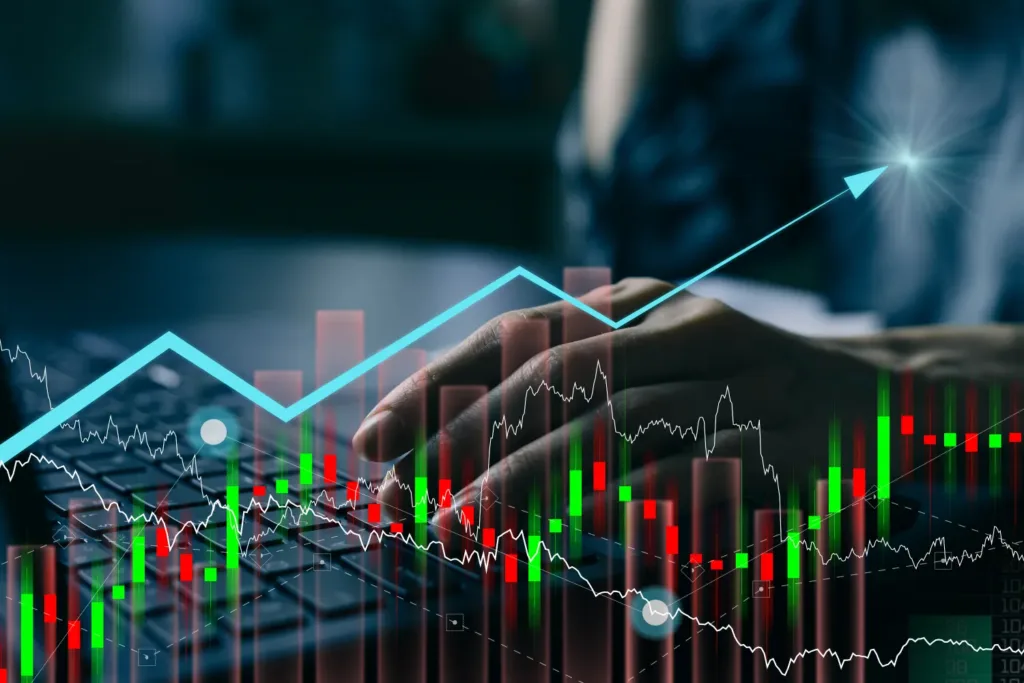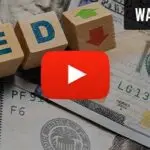Understanding how interest rates affect inflation is important in grasping the broader dynamics of the economy. Interest rates, set by central banks, such as the Federal Reserve in the U.S., are a powerful tool in monetary policy used to control economic activity.
When the Fed adjusts interest rates, it directly influences consumer and business borrowing costs, which affects spending, investment, and, ultimately, the inflation rate. Higher interest rates typically slow economic activity, making borrowing more expensive and saving more attractive, which can help control high inflation by reducing spending and pressure on prices.
Conversely, lower interest rates stimulate economic growth by making borrowing cheaper, encouraging spending and investment but potentially leading to higher inflation if the economy overheats.
We’ll discuss the relationship between interest rates and inflation, exploring how changes in the former can impact the latter, the role of the Federal Reserve, and the broader implications for personal finance, mortgage rates, and the U.S. economy amidst challenges like the pandemic and supply chain issues.
What Is Inflation?
Inflation is an important economic term that describes the rate at which the general level of prices of goods and services rises, leading to a decline in the purchasing power of money.
It means that over time, the same amount of money will buy fewer items than before. This phenomenon is closely monitored by various indices, most notably the Consumer Price Index (CPI), which measures the average change over time in the prices paid by urban consumers for a market basket of consumer goods and services.
What Causes Inflation?
Inflation occurs due to factors influencing the overall price increase across an economy.
These factors can be broadly categorized into three main types:
Demand-pull inflation occurs when the demand for goods and services exceeds the available supply. It can happen during periods of strong economic growth when consumers and businesses spend more. As demand outstrips supply, prices rise in response.
Increases in the cost of production drive cost-push inflation. Factors such as rising labor costs, more expensive raw materials, or increased import prices due to a weaker currency can make producing goods and services more costly for businesses. These businesses often pass these costs onto consumers through higher prices.
Monetary expansion can also result from an increased money supply within an economy. When more money is available, but the number of goods and services remains constant, the currency’s value may decrease, leading to higher prices. Central banks and monetary authorities, like the Federal Reserve in the U.S., manage the money supply through their financial policies.
They adjust interest rates and engage in activities like open market operations to influence economic activity and inflation.
Additional factors contributing to inflation include expectations of future inflation, which can lead to higher wages and prices as businesses and workers try to stay ahead of anticipated cost increases, and supply chain disruptions, limiting the availability of goods and driving up prices.
International factors, such as changes in global oil prices, can also impact domestic inflation rates by affecting the cost of energy and transportation.
Is Inflation a Warning Sign of Recession?
Inflation itself is not a warning sign of a recession, but the relationship between inflation and recession is complicated, with specific inflationary scenarios potentially leading to economic downturns.
Inflation indicates rising prices, which can reflect a healthy, growing economy up to a point. However, when inflation becomes too high and unmanageable, it can lead to negative consequences, contributing to an economic slowdown or recession.
High inflation can erode purchasing power, meaning consumers and businesses can afford to buy less with the same amount of money. This reduction in purchasing power can eventually lead to decreased consumer spending, one of the primary drivers of economic growth. If businesses anticipate reduced demand, they may cut back on production, investment, and workforce, further slowing economic activity.
Central banks, like the Federal Reserve in the U.S., may respond to high inflation by increasing interest rates. While this is done to control inflation by cooling down the economy, significantly higher interest rates can make borrowing more expensive for consumers and businesses. This can lead to decreased spending on everything from consumer goods to new homes and business expansions, potentially tipping the economy into a recession if the policy response is too aggressive or poorly calibrated.
Furthermore, anticipating inflation or the central bank’s actions to combat it can affect consumer and business confidence, leading to cautious spending and investment behavior that can also slow economic growth.
However, it’s important to note that many factors contribute to a recession, and inflation is just one piece of the puzzle. Various issues can trigger recessions, including financial crises, external shocks like oil price spikes or pandemics, and significant corrections in overvalued asset markets.
Therefore, while high inflation can contribute to economic downturns, it is not automatically a precursor to a recession. Monitoring inflation with other financial indicators is essential to understanding the broader economic outlook.
What Is Interest?
Interest represents the cost of borrowing money or the compensation earned through lending money. It’s typically expressed as a percentage of the principal — the initial amount of money borrowed or invested — over a specific period, often annually.
This financial mechanism is central to the banking system, influencing individual financial decisions and the broader economy.
Interest rates are determined by various factors, including policies set by central banks such as the Federal Reserve in the United States. These institutions adjust interest rates to manage the economy’s overall health, aiming to control inflation, encourage job creation, and maintain currency stability.
The level of interest rates can influence everything from the rates you receive on savings accounts to the cost of borrowing for homes and businesses.
What Factors Impact Interest Rates?
Several key factors influence interest rates, shaping the cost of borrowing and the returns on savings across the economy:
- Central Bank Policies: Central banks, like the Federal Reserve, use monetary policy tools to set baseline interest rates. Their decisions aim to control inflation, stabilize the currency, and promote sustainable economic growth.
- Inflation Rate: Generally, higher inflation leads to higher interest rates. Central banks may raise rates to cool down an overheating economy and preserve the currency’s purchasing power.
- Economic Conditions: During economic growth, interest rates might be increased to prevent the economy from expanding too quickly and causing inflation. In contrast, lower interest rates can stimulate spending and investment during economic downturns.
- Government Borrowing: The level of government debt and borrowing can also impact interest rates. Increased demand for credit by the government can lead to higher rates overall.
- Market Demand and Supply: The supply and demand for credit in the broader market can influence interest rates. Interest rates will rise if there’s a high demand for borrowing and a limited supply of funds.
- Global Economic Factors: Global events, such as pandemics or geopolitical tensions, can affect investor confidence and demand for safe investments, influencing interest rates worldwide.
- Credit Risk: Lenders consider the risk of default when setting interest rates for borrowers. Higher-risk individuals or entities will face higher rates to compensate for the increased risk of non-repayment.
How Are Inflation and Interest Rates Related?
Inflation and interest rates are intricately linked through the mechanisms of monetary policy, primarily by central banks like the Federal Reserve in the United States.
Inflation represents the rate of increases in the prices for goods and services, indicating a decrease in purchasing power. Central banks monitor inflation closely, adjusting interest rates to control economic growth and maintain price stability.
Central banks may increase interest rates when inflation is high to cool down the economy. Higher interest rates make borrowing more expensive and saving more attractive, leading to decreased spending and investment, which can help slow down inflation.
Conversely, central banks might lower interest rates during periods of low inflation to encourage borrowing and spending, stimulating economic growth.
The relationship between inflation and interest rates is fundamental to economic policy, aiming to balance growth with price stability. By influencing the cost of borrowing money, central banks can affect consumer behavior, investment decisions, and overall economic activity, steering the economy toward its inflation targets.
Do High Interest Rates Contribute to Inflation?
Contrary to contributing to inflation, high interest rates are typically used to combat inflation. When the central bank raises interest rates, it becomes more expensive for individuals and businesses to borrow money. This reduction in borrowing can lead to decreased spending and investment, cooling down economic activity and reducing inflationary pressures.
High interest rates increase the cost of borrowing money, which can reduce consumer spending on big-ticket items that often require loans, such as houses and cars. For businesses, the higher cost of financing can lead to a slowdown in expansion and investment projects. This overall decrease in demand can put downward pressure on prices, helping to control inflation.
However, while high interest rates can help manage inflation, they must be used carefully. Excessively high rates can slow economic growth too much, potentially leading to a recession. Therefore, central banks aim to find a balance, adjusting rates to keep inflation within their target range without stifling economic activity.
How Can You Protect Your Finances During Inflation?
During periods of inflation, when the purchasing power of money decreases and the cost of goods and services rises, protecting your finances becomes essential. The key is adopting strategies that can help mitigate the impact of inflation on your savings and investments.
Here are several ways to safeguard your finances during a period of inflation:
Diversification
Diversification across various asset classes can reduce the risk of your portfolio being adversely affected by inflation. Consider including investments like real estate and stocks, particularly those in sectors less sensitive to inflation, such as consumer staples or healthcare. Precious metals like gold and silver have historically been hedges against inflation, and a Gold IRA might be a great next step.
Interest-Bearing Bank Accounts
Focusing on interest-bearing bank accounts can help protect your finances. With rising inflation, central banks, like the Federal Reserve, may cause interest rate hikes to control economic overheating. High-yield savings accounts, certificates of deposit (CDs), and money market accounts can offer better returns in a high-interest-rate environment, protecting the actual value of your cash savings.
Consider inflation-protected securities. In the United States, Treasury Inflation-Protected Securities (TIPS) are designed to increase in value along with inflation, ensuring your investment keeps pace with rising prices.
Debt Management
Pay close attention to debt management. When the rate of inflation is high, it often leads to higher interest rates, affecting the cost of borrowing. If you have variable-rate loans, such as credit cards or adjustable-rate mortgages, consider refinancing to fixed-rate options to lock in lower rates before they climb further.
Stay Informed
Staying informed by keeping abreast of economic trends, rising interest rate movements, and inflationary pressures can help you make informed decisions about your finances. Consulting with financial advisors and economists can also provide personalized strategies to understand inflationary periods effectively.
The Bottom Line
Understanding the intricate relationship between interest rates and inflation is essential, especially during economic uncertainty.
Interest rates, set by central banks like the Federal Reserve, are a powerful tool to control inflation, impacting everything from the cost of borrowing to the value of savings. By adjusting your investment strategies, such as diversifying into precious metals, seeking interest-bearing accounts, and managing debts, you can protect your finances against the eroding effects of inflation.
Inflation and interest rates shape the economic environment, influencing personal finance decisions and the economy’s overall health.
For those looking to secure their investments against inflation, American Hartford Gold offers a range of options to diversify and protect your portfolio. Precious metals like gold and silver are known for their inflation-resistant qualities, and American Hartford Gold can confidently help you navigate inflationary periods.
Visit American Hartford Gold today to explore how to safeguard your financial future in any economic climate.
Sources:
What is inflation and how is it measured? | U.S.A. Facts
How does the government measure inflation? | Brookings
Inflation and Interest Rates Relationship Explained | Investopedia
Five tips for protecting your money during high inflation | UNFCU






